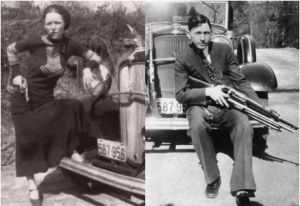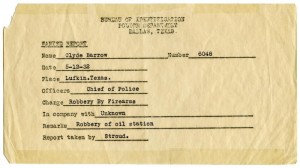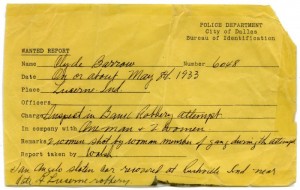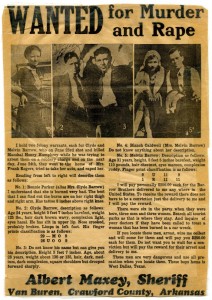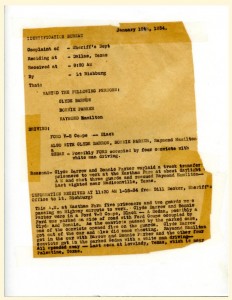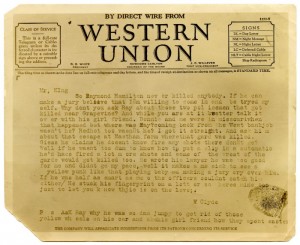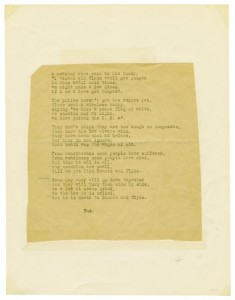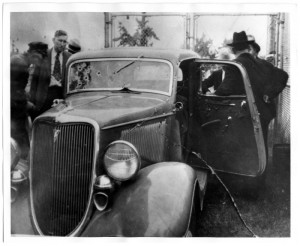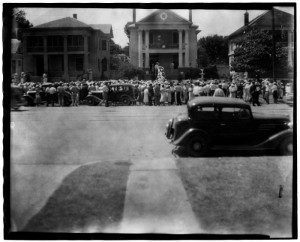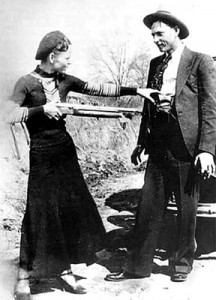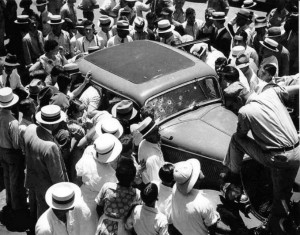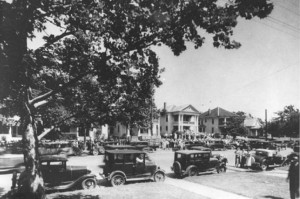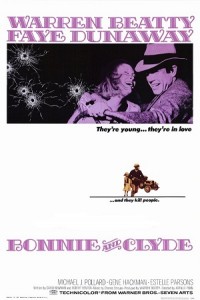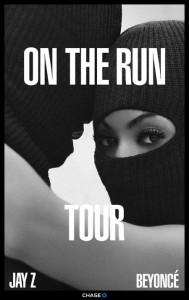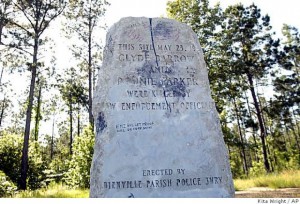Bonnie Parker and Clyde Barrow: photo recovered at Joplin, Missouri, hideout (Source: Library of Congress Prints and Photographs)
jjj
Introduction:
This research guide is a study of the famous outlaw duo Bonnie and Clyde and their existence in American memory. I have divided the guide into two parts. Part one explores Bonnie and Clyde in history and in their own time, the time of the Great Depression. In this section I have included a number of primary sources, many of them from digitized archives. The Dallas Municipal Archives and FBI Vault each provide a trove of primary sources related to the exploits of Bonnie and Clyde. Important among these sources are reports detailing the crimes and accomplices of the Barrow gang, as they provide a clear picture of what happened during Bonnie and Clyde’s crime spree from 1932 to 1934. Some of these sources capture the public’s response to Bonnie and Clyde in the Depression Era, such as the photographs of Bonnie and Clyde’s funerals and the report by the New York Times on their ambush. Photo evidence and personal correspondences, furthermore, offer insight into who Bonnie and Clyde were as people. The accounts of Barrow gang members W.D. Jones and Blanch Caldwell Barrow also help shape the story of what happened in the 1930s and who Bonnie and Clyde were. The secondary sources provided in part one help to put the story of Bonnie and Clyde in the historical context of the Depression Era. They also help debunk some of the mythologized aspects of Bonnie and Clyde’s story that have cropped up throughout the time since their deaths.
jjjjjj Part two of the research guide explores Bonnie and Clyde’s existence in American memory and consists of three sections. The first section covers Bonnie and Clyde’s depiction in film. Arthur Penn’s famous 1967 film Bonnie and Clyde revivified the story of Bonnie and Clyde through a glamorous and romantic depiction of the outlaw couple, but not without controversy. Included along with the movie are a number of reviews of the film and articles discussing its relationship to history and to the memory of Bonnie and Clyde. Another film included in this section is The Bonnie Parker Story, a film that focuses on the figure of Bonnie Parker. The second part of this section covers Bonnie and Clyde’s existence in music. Among popular depictions of the pair in music is a modern day Broadway musical as well as a concert tour by Beyoncé and Jay-Z inspired by the story of Bonnie and Clyde. The third and final section of part two is an examination of Bonnie and Clyde in modern local memory. For this exploration, I have included two news articles describing the monuments, museums, and festivals recalling the story of Bonnie and Clyde.
kk
Part One: In History
Left: Bonnie Parker playfully posing with a pistol and smoking a cigar, Right: Clyde Barrow poses with a gun in front of a car (Source: FBI website)
jj
PRIMARY SOURCES-
1.) Clyde Barrow Gang Collection, 1930-1939. Dallas Municipal Archives. The Portal to Texas History. www.texashistory.unt.edu.
This source is a historical archive of a wealth of digitized artifacts surrounding the history of Bonnie and Clyde and the Barrow gang. It includes over 75 artifacts, ranging from telegrams, letters, news clippings, wanted posters, court documents, fingerprints, police photographs, and more. These artifacts give much information about the crimes themselves and how the police pursued the Barrow Gang. It even includes testimony of members of the Barrow Gang, members who had an inside look into the experience of Bonnie and Clyde.
From the Archive:
(click images to enlarge and read)
Clyde Champion Barrow Wanted Poster, 1932 – Sherman, Texas. Poster. Clyde Barrow Gang Collection, 1930-1939. Dallas Municipal Archives. University of North Texas Libraries, Dallas, TX.
Wanted posters such as these are important sources in understanding what crimes Bonnie and Clyde were responsible for committing. This wanted poster charges Clyde with the murder of Howard Hall, a grocery store clerk, on October 11th, 1932. It also alleges that Barrow was wanted for the various robberies and the murder of multiple policeman throughout the Texas-Oklahoma area.
_____________________________________________________________
Clyde Champion Barrow Mug Shot – Dallas 6048. Image. Clyde Barrow Gang Collection, 1930-1939. Dallas Municipal Archives. University of North Texas Libraries, Dallas, TX.
This source, like the previous, is important in identifying what crimes the Barrow gang was held responsible for committing. This wanted poster includes Clyde Barrow’s mugshot and a description claiming he is wanted for a robbery at a gas station.
_____________________________________________________________
Dallas (Tex.) Police Dept. “Clyde Champion Barrow Wanted Report, 05/12/1932 – Dallas, Texas Police Department,” May 12, 1932. Clyde Barrow Gang Collection, 1930-1939. Dallas Municipal Archives. University of North Texas Libraries, Dallas, TX.
This source is an example of a police report of a crime committed by Clyde Barrow. The report indicates Barrow robbed a an oil station in Luftkin, TX.
_____________________________________________________________
Dallas (Tex.) Police Dept. Letter, “Clyde Champion Barrow Wanted Report, 08/01/1932 – Dallas, Texas Police Department,” August 1, 1932. Clyde Barrow Gang Collection, 1930-1939. Dallas Municipal Archives. University of North Texas Libraries, Dallas, TX.
In this police report, Clyde Barrow is accused of having robbed a meat packing house. This police report also is among the first to include Raymond Hamilton as one of Clyde Barrow’s accomplices. Hamilton would go on to commit several more crimes with Clyde as a member of the Barrow gang, including the famous Grapevine murder.
_____________________________________________________________
Sibley, W.R. Report, “Clyde Champion Barrow Wanted Report, 10/13/1932 – Abilene, Texas,” October 13, 1932. Clyde Barrow Gang Collection, 1930-1939. Dallas Municipal Archives. University of North Texas Libraries, Dallas, TX.
This wanted report charges Barrow with having staged a robbery at a Piggly Wiggly grocery store in Waco, TX. It gives a description of other crimes for which Barrow is wanted, including other robberies, murder, and assault. It lists Raymond Hamilton as an accomplice and also is one of the first to mention Bonnie Parker as an accomplice.
_____________________________________________________________
Dallas (Tex.) Police Dept. Report, “Clyde Champion Barrow Wanted Report, 05/08/1933 – Dallas, Texas Police Department,” May 8, 1933. Clyde Barrow Gang Collection, 1930-1939. Dallas Municipal Archives. University of North Texas Libraries, Dallas, TX.
This wanted report implicates Clyde Barrow in the attempted robbery of a bank in Luserne, IN. A brief description of the incident describes Barrow as being accompanied by two women. It furthermore claims one of the women was shot in the attempted robbery.
_____________________________________________________________
“Barrow Gang” Wanted Poster, 1933 – Van Buren, Arkansas. Poster. 1933. Clyde Barrow Gang Collection, 1930-1939. Dallas Municipal Archives. University of North Texas Libraries, Dallas, TX.
This is a wanted poster for the the Barrow gang, whose members include Bonnie Parker (left photo), Clyde Barrow (middle photo, left), Blanch Barrow (right photo, left), “Melvin” (Buck) Barrow (right photo, right), and an unidentified young man, likely W.D. Jones (middle photo, right). The poster describes the Barrow brothers as being wanted for murder, attempted car robbery, and rape. This is one of the few instances wherein the Barrow gang was associated with the charge of rape. Another important aspect of the poster is the description of Bonnie Parker: she is said to be badly burned and to have a tattoo on her thigh, several inches above the knee. For a woman to have a tattoo in this era was uncommon and somewhat scandalous. The burn the poster describes was sustained in a car accident in 1933. This burn left Bonnie partially crippled; she could only hop on one leg and was often carried by Clyde after the accident according to Jeff Guinn and W.D. Jones.
_____________________________________________________________
Dallas (Tex.) Police Dept. Memorandum, “Dallas, Texas Sheriff’s Department Complaint of the Eastham Prison Break-out,” January 15, 1934. Clyde Barrow Gang Collection, 1930-1939. Dallas Municipal Archives. University of North Texas Libraries, Dallas, TX.
This report describes the famous Eastham Farm Prison break-out staged by the Barrow gang. According to the report, Bonnie and Clyde halted a truck transferring prisoners, “shot three guards and rescued Raymond Hamilton.” Several other prisoners also escaped in the break-out in addition to Hamilton.
_____________________________________________________________
Barrow, Clyde. Telegram, “Clyde Barrow Telegram to Dallas, Texas District Attorney,” n.d. Clyde Barrow Gang Collection, 1930-1939. Dallas Municipal Archives. University of North Texas Libraries, Dallas, TX.
This is a telegram from Clyde Barrow addressed to District Attorney King. In it, Clyde accuses Raymond Hamilton of committing the infamous Grapevine murders, which was the murder of two police officers in Grapevine, TX. The murders negatively affected public sentiment concerning Bonnie and Clyde and revivified efforts to capture Bonnie and Clyde. Clyde claims he and Bonnie were not even in Texas at the time of the murders.
_____________________________________________________________
Parker, Bonnie. Poem, “The Trail’s End,” n.d. Clyde Barrow Gang Collection, 1930-1939. Dallas Municipal Archives. University of North Texas Libraries, Dallas, TX.
This is a poem written by Bonnie Parker, recovered at the Joplin, MO, hideout. The poem is one of the contributing factors to Bonnie and Clyde’s popularity among the public in their day. The poem describes “awful hard times,” “weariness,” and the sufferings of the people in the Depression Era south. In the poem, Parker also expresses Bonnie and Clyde’s resolution to never “give up until they died,” citing death as “the wages of sin.” The poem has reemerged many times in pop culture: in Arthur Penn’s Bonnie and Clyde and in multiple songs, including Merle Haggard’s “The Legend of Bonnie and Clyde.”
_____________________________________________________________
Clyde Barrow and Bonnie Parker’s Bullet Hole-Ridden V8 Ford. Photograph. Clyde Barrow Gang Collection, 1930-1939. Dallas Municipal Archives. University of North Texas Libraries, Dallas, TX.
This is an image of Bonnie and Clyde’s famous V-8 Ford, riddled with bullets. Bonnie and Clyde were killed when police ambushed their vehicle in Bienville Parish, LA, on May 23rd, 1934. Six officers shot numerous rounds into their car, possibly exceeding a hundred bullets total.
_____________________________________________________________
Bonnie Parker’s Funeral – Dallas, TX. Photograph. 1934. Clyde Barrow Gang Collection, 1930-1939. Dallas Municipal Archives. University of North Texas Libraries, Dallas, TX.
This image shows Bonnie Parker’s funeral. Multiple, possibly thousands of people can be seen attending her funeral in this photograph. The immense size of the gathering says much about the public’s fascination with Bonnie and Clyde in the Depression Era.
_____________________________________________________________
2.) “Bonnie and Clyde in Oklahoma.” Oklahoma Department of Libraries Online. Last modified 2014. Accessed December 1, 2014. http://www.odl.state.ok.us/oar/resources/bonnieclyde/low.htm.
This is a presentation created by the Oklahoma Department of Libraries. It provides a number of primary sources surrounding a murder committed by members of the Barrow gang in Oklahoma on April 6th, 1934, just after the Grapevine murders. It provides photographs of the crime scene and transcripts from the trial of Henry Methvin, one of the Eastham Farm prison escapees (Methvin v. Oklahoma State, 105 1936 OK CR [1st Cir. 1936]). One of the important documents from the trial is the examination of the defendant Henry Methvin, who describes in detail the what occurred, offering an interesting, albeit assuredly biased as Methvin was on trial for murder, eyewitness account of one of the Barrow gang’s murders.
_____________________________________________________________
3.) “Barrow and Woman Are Slain by Police in Louisiana Trap.” New York Times (New York, NY), May 23, 1934.
This is an article by the New York Times reporting on the ambush of Bonnie and Clyde. The article describes the event and Bonnie and Clyde, saying, “Clyde Barrow, notorious Texas ‘bad man’ and murderer, and his cigar-smoking, quick-shooting woman accomplice, Bonnie Parker, were ambushed and shot to death today in an encounter with Texas Rangers and Sheriff’s deputies.” The author characterizes Frank Hamer, the famous Texas Ranger who is credited with having tracked down Bonnie and Clyde, as a hero figure who caught two villains. The description of the ambush in this article is a point of interest in that it conflicts with other accounts of the ambush, claiming that Clyde attempted to run down the officers with his car.
_____________________________________________________________
4.) U.S. Department of Justice. “FBI Records: The Vault, Bonnie and Clyde.” The Federal Bureau of Investigation. Last modified May 2009. Accessed December 1, 2014. http://vault.fbi.gov/Bonnie%20and%20Clyde.
Federal Bureau of Investigation. Bonnie and Clyde Horsing Around With a Gun. Photograph. Famous Cases and Criminals. FBI Records: The Vault.
This image was among the many recovered at the Joplin, MO, hideout. It shows Bonnie playfully pointing a gun at Clyde. This photograph has since emerged multiple times in pop culture and is one of the more famous images of the duo.
_____________________________________________________________
Federal Bureau of Investigation. Identification Order No. 1227, Bonnie and Clyde. Photograph. December 2006. FBI Records: The Vault.
This is a wanted poster for Bonnie Parker and Clyde Barrow produced by the Department of Justice. Because Bonnie and Clyde’s crimes criss-crossed state borders, the FBI became involved in the investigation of their crimes. Among Bonnie’s relatives, the poster lists her husband Roy Thorton, to whom she was still married when she met Clyde Barrow. This poster also gives a description of the wounds on Bonnie’s legs and describes a walking impairment.
____________________________________________________________
Federal Bureau of Investigation. Bonnie and Clyde Part 03 of 07, pg. 49. Photograph. FBI Records: The Vault.
This photograph shows the crowd that gathered around Bonnie and Clyde’s car after the ambush in Louisiana. Shortly after the ambush occurred, a large group of spectators came to the scene of their deaths as police were attempting to collect evidence. According to historical sources, several members of the crowd began taking souvenirs from the car, like shards of glass and bullet shell casings, and from the bodies of Bonnie and Clyde themselves, including locks of Bonnie’s hair, pieces of their clothing, and (according to Milner) one individual even attempted to take one of Clyde’s ears. The aftermath of the ambush and the immense crowd here again indicate the public fascination with Bonnie and Clyde.
_____________________________________________________________
Federal Bureau of Investigation. Bonnie and Clyde Part 03 of 07, pg. 5. Photograph. FBI Records: The Vault.
This is a photograph taken from Clyde’s funeral. His funeral, like Bonnie’s, drew a large crowd numbering into the thousands. In The True Story of Bonnie and Clyde written by Bonnie’s mother and Clyde’s sister, the authors describe how at the funeral popcorn and candy stands were erected at the funeral due to the large crowd it attracted.
_____________________________________________________________
5.) Barrow, Blanche Caldwell. My Life With Bonnie and Clyde, edited by John Neal Phillips. Norman: University of Oklahoma Press, 2004.
This is a memoir written by Blanche Barrow, a member of the Barrow gang and wife of Buck Barrow. Barrow wrote the book as she served time from 1933-1939 in the Missouri State Penitentiary. The memoir was recovered after her death by a friend and published into a book by Bonnie and Clyde history expert John Neal Phillips, a Dallas professor and author of Running With Bonnie and Clyde: The Ten Fast Years of Ralph Fults. Of the memoir, Phillips said, “despite the author’s prejudicial viewpoint toward her husband, these passages paint a very intriguing overall picture of the seductiveness of crime and the psychology of the fugitive mentality, this overwhelming sense of ‘us against them’.”
_____________________________________________________________
6.) Jones, W.D. “Riding With Bonnie and Clyde.” Playboy Magazine, November 1968.
In this source, Barrow gang member W.D. Jones tells the tale of his experience with Bonnie and Clyde. He wrote the piece shortly after the release of Arthur Penn’s Bonnie and Clyde and attempts to debunk some of the sensationalization of the lives of Bonnie and Clyde perpetuated by the movie and other sources. Jones describes Clyde as polite and clever and asserts that he never wanted to kill except when he felt he must. He addresses the claims (put forth by John Toland in The Dillinger Days) that Clyde was a homosexual saying, “I was with him and Bonnie. I know. It just ain’t true.” He also addresses the media coverage of the gang’s crimes in the 1930s and the portrayal of their group as bank robbers, asserting, “Some of the tales about us robbing banks all the time ain’t true, either. The time I was with Clyde and Bonnie, we never made a bank job. He liked grocery stores, filling stations and places there was a payroll. Why should we rob a bank? There was never much money in the banks back in them days in the Southwest. But that’s not the way the papers put it.” He additionally alleges that Bonnie never smoked cigars, as she is often said to have done, or even fired a gun. While his version of events may be biased in his desire not to implicate himself in any of the murders, for example, his story is a valuable eye witness account of the Barrow gang’s exploits.
_____________________________________________________________
SECONDARY SOURCES-
1.) Guinn, Jeff. Go Down Together: The True Untold Story of Bonnie and Clyde. New York: Simon & Schuster, 2009.
This book serves as one of the best Bonnie and Clyde resources to date. Based primarily on primary source research, the book analyzes the story of Bonnie and Clyde not just in the years of their crime spree from 1932-1934, but from their adolescence growing up in the slums of West Dallas, a place Guinn describes as an absolute “hellhole.” The book does a particularly good job of setting the story of Bonnie and Clyde in the historical context of the Depression Era 1930s, explaining possible reasons for why the public became so fascinated with the couple. Here, “the legend still stands under its own power. Bonnie and Clyde’s death dance is more terrifying told in real time here than it was in the [Arthur Penn] film’s famous special effects scene,” says reviewer Jackie Loohauis-Bennett. In addition to this book, I have included Loohauis-Bennett’s brief review of the book and a citation and link to an audio file of Jeff Guinn’s lecture on his book at the Kansas City Library in 2009 which highlights some of the essential elements of the book.
Loohauis-Bennett, Jackie. “Well-Researched Book Targets Bonnie and Clyde Myth.” McClatchy – Tribune Business News, Mar 14, 2009. http://search.proquest.com/docview/464866375?accountid=9676.
Guinn, Jeff. “Jeff Guinn: Go Down Together.” Lecture, Kansas City Public Library, Plaza Branch, Kansas City, MO. March 26, 2009. Audio file. Internet Archive. 2011. Accessed December 1, 2014. https://archive.org/details/JeffGuinnGoDownTogether.
_____________________________________________________________
2.) Milner, E.R.. The Lives and Times of Bonnie and Clyde. Carbondale: Southern Illinois University Press, 2003.
This book, like Guinn’s Go Down Together, is an even-handed portrayal of the lives of Bonnie and Clyde. The book, unlike many others, spends time discussing Bonnie and Clyde as individuals, rather than in the context of their crimes or lives together, giving a full view of who these historical figures were as people. Milner, a history professor at Tarrant College, focuses primarily on primary source research and includes a number of useful sources to demystify the legendary qualities of the story of Bonnie and Clyde, among these, letters, diaries, newspaper articles, and more.
_____________________________________________________________
3.) Toland, John. The Dillinger Days. New York: Random House Publishing, 1963.
Published in 1963, this book is the one on which the historical aspects of the famous 1967 film, Bonnie and Clyde, is based. The book includes the stories of multiple outlaws in the time of the Depression Era, but focuses primarily on the story of famed outlaw John Dillinger. In the book, there is one important chapter that tells about Bonnie and Clyde. Toland controversially claimed that Clyde Barrow was a homosexual, a claim that would have significant influence over his character and Warren Beatty’s portrayal in the 1967 movie.
_____________________________________________________________l
kkkk
Part Two: In Memory
Movie poster for Arthur Penn’s 1967 classic, Bonnie and Clyde. Tagline: “They’re young, they’re in love, and they kill people.” (Source: Wikipedia).
1.) Film
Bonnie and Clyde. Directed by Arthur Penn, performed by Warren Beatty and Faye Dunaway. 1967. U.S.: Warner Bros.-Seven Arts. Film.
This film, according to multiple sources found in this research guide, re-popularized the story of Bonnie and Clyde in American pop culture. Produced at the height of the Counter-Culture Era, this film connected with many of its young audience and, despite early criticism, won two Academy Awards. Upon its release, the film encountered much controversy and criticism for its graphic nature and apparent glorification of violence and criminals. In many ways, it glamorizes the story of Bonnie and Clyde and deviates from historical reality. One such deviation is the film’s portrayal of Clyde as impotent. According to interviews with the writers and makers of the movie (below) Clyde was originally written to be portrayed as bisexual, based on the claim by John Toland in The Dillinger Days that Clyde was a homosexual. This was considered too controversial for the time period and the character was re-written as impotent. W.D. Jones and Blanch Barrow, members of the Barrow gang, also criticized the movie for its depictions of their respective characters and those of Bonnie and Clyde. Frank Hamer, the respected Texas Ranger that tracked down Bonnie and Clyde, is also portrayed as the spiteful, revenge-seeking villain of the movie. The movie, furthermore, evades many of the darker aspects of Bonnie and Clyde’s story, and instead focuses on the romantic aspects of the Bonnie and Clyde legend. Included below along with this source is the movie’s trailer, which features the film’s famous gunfight scenes and the tagline “They’re young, they’re in love, and they kill people.” Additionally, there are also two reviews of the film, written upon the 30th anniversary of its release, one of them (“Blasts from the Past”) including extensive interviews with the film’s director, producers, writers, and actors.
Warner Bros.-Seven Arts, Inc. “Bonnie and Clyde Trailer.” 1967. Online video clip. American Film Institute: afi.com (accessed November 19, 2014). http://www.afi.com/10top10/moviedetail.aspx?id=19356&thumb=1
Reviews:
Goldstein, Patrick. “Bonnie & Clyde & Joe & Pauline.” Los Angeles Times (Los Angeles, CA), August 25, 1997.
Goldstein, Patrick. “Blasts From the Past.” Los Angeles Times (Los Angeles, CA), August 24, 1997.
_____________________________________________________________
Toplin, Robert Brent. “Cinematic History: Where Do We Go From Here?” The Public Historian 25, No. 3 (Summer 2003), pp. 79-91.
This is an article discussing the relationship between film and history, citing Bonnie and Clyde as a significant example of that relationship. Toplin suggests that the art form of film molds historical events to deliver a message about the present, Bonnie and Clyde being an example of that in its being a reflection of the Counter-Culture Era. Filmmakers, asserts Toplin, choose the subjects of their historical films based on, “current fashions, attitudes, hopes, and anxieties of the viewing public.” Of Bonnie and Clyde, Toplin claims, “Hollywood’s Bonnie Parker and Clyde Barrow were anti-establishment, rebellious, and independent-minded. They also craved celebrity. David Newman, who helped to develop the original concept for this movie, promoted his project as a story about an unconventional couple that ‘would have been right at home in the Sixties.’ The movie, Bonnie and Clyde, was not only about two historical figures, he said; it was also ‘about what’s going on now.’” With this source I have included a citation of Toplin’s book History by Hollywood: The Use and Abuse of the American Past, which is a grander analysis of what he puts forth in this article.
Toplin, Robert Brent. History by Hollywood: The Use and Abuse of the American Past. Urbana: University of Illinois Press, 1996.
_____________________________________________________________
Cardullo, Bert. “Look Back in Bemusement: The New American Cinema, 1965–1970.” The Cambridge Quarterly 37, no. 4 (2008): 375-386. http://muse.jhu.edu/ (accessed November 28, 2014).
This article takes a look at American films produced in the time of the New American Cinema from the years 1965-1970, citing Bonnie and Clyde (1967) as one of three films representing the changing film industry in this era. According to Cardullo, Bonnie and Clyde, along with The Graduate (1968) and Easy Rider (1969), was a reflection of prevailing attitudes towards society in the time of its making and release. This article focuses on explaining how Bonnie and Clyde and these other American films, “were exemplary and influential expressions of, that new spirit of political and cultural insubordination, that amateur and informal (anti-formal in some of its manifestations) call to order by which it was hoped that the frozen values and procedures of the dominant bourgeois society – forever faithful to sanctified forms and thus forever reproducing them – would be not so much overthrown as displaced.”
____________________________________________________________
Hunter, Stephen. “Bonnie and Clyde Died For Nihilism.” Commentary 127, no. 7 (2009), pp. 77-80.
This source is an essay published in an academic journal describing the exploits of Bonnie and Clyde and the exploitation of their story in the media and pop culture, particularly in the movie Bonnie and Clyde. The author, who writes from a poignantly conservative and biting perspective, vilifies Bonnie and Clyde and those who have mythologized their story. He also faults those who revere the criminals as misfit heroes in the Depression Era and villainize the lawmen who pursued them. He discusses the portrayal of Frank Hamer in Penn’s Bonnie and Clyde, who was a well-respected man of the law and somewhat of a folk hero himself. He claims the movie depicted him as a vengeful buffoon who preferred to chase those who flouted him rather than help the people suffering in the Depression. I have included an important excerpt below:
“That all changed in 1967 when Arthur Penn’s film version came out with Warren Beatty and Faye Dunaway and created the Bonnie and Clyde most people remember: vibrant, beautiful movie stars with witty ripostes on their lips and grace in their limbs and superbly tailored haberdashery on their shoulders, while bluegrass legends Flatt & Scruggs plucked away brilliantly behind them. Quickly, they commanded the allegiance of Baby Boomers hungry for anti-establishment heroes, killed (virtually crucified) by ruthless officers out of mean-spirited vengeance. It was an easy generational transference for the nascent Boomers to see themselves as so beautiful, so in love, so radical, so entitled to self-expression, so embittered by a failing economic system, so martyred by a crusty older generation that despised them for those attributes exactly.”
_______________________________________________________jk
The Bonnie Parker Story. Directed by William Witney, performed by Dorothy Provine. 1958. U.S.: American International Pictures. Film.
This is a film from 1958, which deviates greatly from the story of Bonnie and Clyde. The movie stars Dorothy Provine as Bonnie Parker, a “Cigar smoking hellcat of the roaring ‘thirties,” who leads a gang of criminals in a series of robberies and murders throughout the Southwest. In the movie, there is no Clyde Barrow, but rather Bonnie has a side-kick, Guy Darrow, who aids her in robberies and eventually in breaking her husband, Duke Jefferson, out of prison. In a botched robbery, Guy kills Duke, and he and Bonnie run away together until they are gunned down together in Louisiana. This film tells a story remarkably far from the story of Bonnie and Clyde, but it is significant for its characterization of Bonnie Parker as the scandalous and aggressive head of the criminal gang. Below I have included the movie’s advertising poster that shows Bonnie firing a machine gun while smoking a cigar.
Brown, Reynold. “Advertising Poster for the Film ‘The Bonnie Parker Story’” 1957. Poster.
_____________________________________________________________
3.) Music
Brantley, Ben. “Armed and Amorous Committing Cold-Blooded Musical: ‘Bonnie and Clyde’ With Laura Osnes and Jeremy Jordan.” New York Times (New York, NY), December 1, 2011.
This is an article from the New York Times reviewing the musical “Bonnie and Clyde” starring Jeremy Jordan and Laura Osnes. The article describes the depictions of Bonnie and Clyde as that of wild kids seeking fame. Most importantly, it describes how the story of Bonnie and Clyde is portrayed in relation to contemporary culture. Says Brantley: “Instead, this show has repackaged the tale of Bonnie and Clyde as a Story for Our Time, with implicit parallels between the lost ideals of one American era of privation and unemployment and our own. ‘This country’s had its day,’ Clyde snarls. That pronouncement is reflected in Tobin Ost’s weathered wooden sets, overlaid with Aaron Rhyne’s video projections, which summon the Dust Bowl images of photographers like Dorothea Lange.” The link provided below contains a series of clips of scenes and songs from the musical.
https://www.youtube.com/watch?v=5ExnfSJfOMw
Laura Osnes and Jeremy Jordan in the “Bonnie and Clyde” musical (Source: New York Times)
________________________________________________________
Advertisement for the “On the Run Tour” starring Beyonce and Jay-Z (Source: Live Nation Entertainment)
“’03 Bonnie and Clyde”, On the Run Tour. Performed by Jay-Z and Beyoncé. Stade de France, Paris, September 12 and 13, 2014. Home Box Office, 2014.
https://www.youtube.com/watch?v=URkhRSYpUIU.
This song, which is the first song made by recording artists Beyoncé and Jay-Z together from 2003, is the inspiration for the theme of their co-headlined 2014 “On the Run” concert tour. The tour includes staged videos of Beyoncé and Jay-Z acting as robbers, holding up banks, and carrying guns, which play along with their performances. This is a video showing Beyoncé and Jay-Z’s performance of “’03 Bonnie and Clyde” on their tour together. The song casts the famous music couple as the modern day Bonnie and Clyde. The song includes such lyrics as, “[Jay] All I need in this life of sin, is me and my girlfriend / [Bey] Down to ride ’til the very end, it’s me and my boyfriend.” In the video, Beyoncé wears a ski mask during the performance while Jay-Z wears a shirt bearing a black and white America flag. These symbols of the American flag and of robbers have a prominent role throughout the “On the Run” tour
“Part II (On the Run)”, On the Run Tour. Performed by Jay-Z and Beyoncé. Stade de France, Paris, September 12 and 13, 2014. Home Box Office, 2014.
https://www.youtube.com/watch?v=wiIu3VwuoiU.
This video is a performance of the follow-up song to “’03 Bonnie and Clyde.” The song performed includes such lyrics as “[Bey] Without you I got nothing to lose / [Jay] I’m an outlaw, got an outlaw chick,” and, “[Jay] She fell in love with the bad guy…/ [Bey] If it’s me and you against the world, then so be it.” The song plays on the romantic aspects of the Bonnie and Clyde legend in relating Beyonce and Jay-Z to a modern day Bonnie and Clyde. In this performance, as in that of “’03 Bonnie and Clyde,” a black and white American flag is included, this time as the skirt of Beyoncé’s dress.
hhh
5.) Local Memory
Severely defaced monument marking the cite of Bonnie and Clyde’s deaths (Source: Associated Press)
Foster, Mary. “Town where Bonnie and Clyde checked out.” SFGate (San Francisco, CA), May 24, 2009.
This source is a news article describing the events surrounding the 75th anniversary of Bonnie and Clyde’s deaths in the town of Gibsland, Louisiana. The author describes a festival that is to be held to commemorate the event. The festival’s attractions include “four re-enactments planned for the festival… a pancake breakfast, parade and Bonnie and Clyde look-alike contest.” The article describes the memory of Bonnie and Clyde in the town of Gibsland as mysterious, romantic, and, importantly, as a source of income for the tiny town. Says the town’s mayor, Pat White, “‘For us it’s timber, oil and Bonnie and Clyde’.”
Hallman, Tristan. “Legacy of Dallas-based bank robbers Bonnie and Clyde lives on.” Dallas News (Dallas, TX), May 18, 2014.
This article is a story by a Dallas newspaper describing a Bonnie and Clyde museum located in Gibsland, LA. It features an interview with the museum’s curator, Boots Hinton, who is the son of one of the policemen that brought down Bonnie and Clyde, Ted Hinton. The Bonnie and Clyde Ambush Museum captures how the pair “went from an early life in the slums of West Dallas to become national icons, folk heroes, villains and hunted criminals,” through a collection of Bonnie and Clyde memorabilia that even includes a personal film by Ted Hinton shot immediately after the ambush of Bonnie and Clyde. The article also importantly includes interviews from relatives of Bonnie and Clyde and their experience grappling with their association with the famous pair. In the town of Gibsland, Bonnie and Clyde’s memory lives on in, “the imagination of the public, Hollywood, haunted descendants and [t]here on Main Street.”

